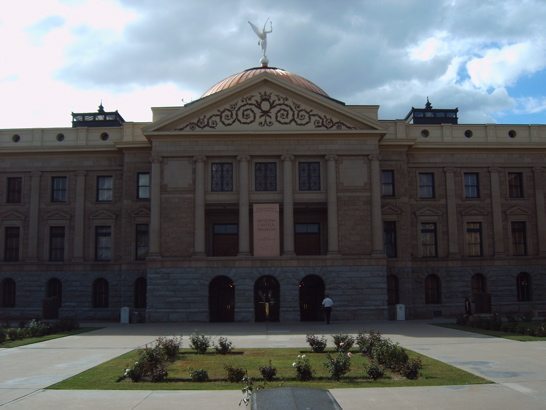Valley Partnership defines itself as an advocacy organization with responsible development at its core. Behind the organization’s educational Friday Morning Breakfasts, networking mixers, fundraisers and annual community project, Valley Partnership has three committees that work year-round on the organization’s advocacy efforts on a federal, state and cities/county issues.
“Keeping with Valley Partnership’s focus on supporting water security for our economic vitality, economic development tools such as state land funding and consistent policies on taxes and fees, we had a successful year to build toward 2016 with the federal government, Arizona State Legislature and Valley cities,” says Cheryl Lombard, president and CEO of Valley Partnership.
Law of the Land
Arizona is the sixth-largest state, yet only 17 percent of its land is private. The role available land plays in economic activity is incomparable to East Coast states, says DMB Associates Executive Vice President Karrin Talyor.
States on the East Coast are nearly 98 percent private land, meaning there is a higher percentage (or less land) that exists as productive tax-producing land. Such disparity can make it difficult to draft legislation that can fairly apply to all states, says Taylor.
“When you overlay the federal land, conservation land, clean water and critical habitats, there’s nothing left,” says Taylor. “You overlay all these regulations and you wonder, ‘How do you pay for economic activity?’”
Taylor says there is the possibility of more land that may be taken away from productive use in the name of conservation before the end of President Barack Obama’s second term. She notes that former President Bill Clinton created the Sonoran Desert Monument before the end of his term. It was a designation that she says removes land from being leased for grazing, mining or other economically vital purposes.
Valley Partnership’s Federal Affairs Committee, which Taylor helped form about three years ago, is a gathering place for representatives from different delegations to discuss these topics.
“Part of it is raising awareness,” says Taylor. “We routinely have four or five representatives from delegations every month to exchange information. I don’t know if some of these staffers get together in other situations.”
The Arizona State Land Department (ASLD) is one such group that attends committee meetings.
“Valley Partnership Committees (give) ASLD the opportunity to meet with local government representatives and discuss issues of mutual importance including land planning efforts that can enhance the value of ASLD land and increase economic opportunities,” says Bill Boyd, legislative policy administrator for ASLD. “Valley Partnership provides a forum helping ASLD to be active in the local business community by sharing information about land acquisition and development opportunities while contributing to an ongoing understanding of the condition of the local and regional economy.”
Cue the Water Works
In 2014, Intel Corporation, Sundt Construction, Carollo Engineers and the city of Chandler entered into a unique public-private partnership to tackle one of the biggest resource issues facing Arizona — water.
When Intel expanded its Ocotillo Campus in Chandler, its facility was going to create more waste streams that would add pressure to the city’s reverse osmosis facility (CHRO), which treats water for reclamation.
Salinity and total dissolved solids, referred to as TDS, are rising in reclaimed water throughout the Valley and most growing cities. Reclaimed water is what’s used to irrigate public spaces in the city of Chandler. As reclaimed water quality drops, water shortages sit on the horizon. This is particularly an issue that arises when an industrial facility like one expanded by Intel increases its own need for water. Therefore, Intel went to work on developing the Ocotillo Brine Reduction Facility, which would accommodate the increased waste streams and also contribute to upgrades at the CHRO facility. In the end, The OBRF project also eliminated discharges from the CHRO facility to the sewer – improving operations at the city’s water reclamation facility.
This project is an example of what Valley Partnership’s members are about. Sundt Construction, one of the oldest Arizona-based construction companies at 125 years old, is ahead of its time in bringing together the private and public sectors to build a project that’s responsible and sensitive to the future of Arizona.




